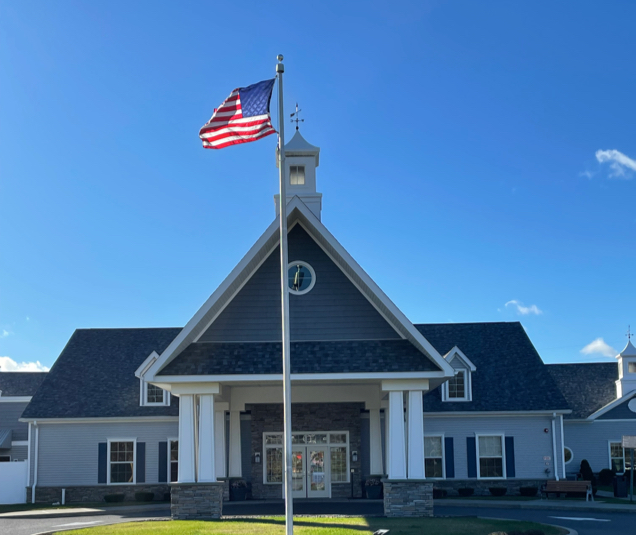For families navigating the emotional process of finding the right community for their loved one, understanding how staffing levels impact care is important. A well-balanced staff-to-resident ratio isn’t just a number—it’s a lifeline for residents and a reassurance for families.
The number of caregivers per resident in memory care can vary. Higher caregiver-to-resident ratios mean more personalized care, better safety, and greater peace of mind for families.
Caregiver-to-Resident Ratios
Caregiver-to-resident ratios play a central role in the daily lives of those with conditions that cause cognitive decline, such as Alzheimer’s or dementia. Memory care residents typically face challenges that require ongoing assistance like:
- Daily tasks
- Communication
- Personal hygiene
A good staffing ratio ensures residents receive timely support while creating an environment where they feel safe, valued, and respected.
If staffing levels are too low, caregivers may not have enough time for meaningful interactions with residents. This can lead to unmet needs, diminished emotional well-being, and a sense of isolation.
What Affects Staffing Levels in Memory Care?
Every memory care community has unique circumstances that determine its caregiver-to-resident ratio. Here are some common factors that influence staffing levels:
Level of Care Needed
Residents in memory care often require varying degrees of assistance with tasks like eating, dressing, or medication reminders. Communities with residents who need more hands-on care generally require higher staffing levels.
Community Size
Larger communities may appear to have more staff at first glance, but what truly matters is how well those staff numbers align with the number of residents.
Services Offered
Communities that emphasize holistic and specialized care—such as including recreational activities or therapies—may require additional staff to maintain a well-rounded schedule.
Time of Day
Some communities adjust staffing throughout the day, increasing the number of caregivers during mornings and evenings when residents need the most support.
Common Caregiver-to-Resident Ratios in Memory Care Communities
While caregiver-to-resident ratios differ across communities, there are some industry standards that families can expect.
Many memory care communities operate with day-to-day ratios ranging from one caregiver for every 5 residents to one caregiver for every 8 residents, depending on the time of day.
These ratios can vary during overnight hours, with one caregiver often attending to 10—15 residents. That said, the ideal ratio depends largely on the complexity of residents’ needs.
Smaller ratios generally allow staff to provide more individualized attention, ensuring residents feel heard and cared for.

Personalized Care & Individual Needs
No 2 individuals experiencing memory loss are the same, and the best memory care communities recognize the need for personalized approaches. Even within the same community, residents may have vastly different support requirements.
Someone in the early stages of dementia may need only occasional assistance, while another resident may require assistance throughout the day for basic activities.
A smaller caregiver-to-resident ratio enables staff to respond to these differences thoughtfully. With the right ratio, caregivers can dedicate time to truly understanding each resident’s preferences, history, and daily rhythms—ultimately improving emotional and physical wellness.
Questions to Ask About Staffing During a Tour
When visiting or researching a memory care community for your loved one, asking the right questions about staffing can help you gauge its commitment to quality care. Here are a few questions to consider:
- What is the caregiver-to-resident ratio during the day? At night?
- Are staff members trained specifically in memory care and dementia support?
- How does the community handle emergencies when more staff may be needed?
- Do caregivers have enough time for one-on-one interactions with residents?
- Is there a clear plan for managing shifts during busy or high-demand times?
The answers to these questions will give you a better sense of how the community prioritizes the needs of its residents and ensures an enriching environment.
Benefits of Adequate Staffing for Residents & Families
An appropriate caregiver-to-resident ratio provides benefits that extend far beyond basic care. For residents, it means:
- Quicker response times
- Better emotional connections
- A tailored approach to their unique situations
This helps residents feel seen, understood, and respected—key elements for someone navigating memory loss.
For families, knowing that there are enough caregivers to meet their loved one’s needs brings peace of mind. It also builds trust and confidence in the community, allowing families to focus on cherishing moments with their loved one rather than worrying about day-to-day logistics.
How Peregrine Senior Living Ensures Quality Care
At Peregrine Senior Living, we take our caregiver-to-resident ratios seriously, always ensuring that our staffing levels are designed to meet the individual needs of every resident. But we don’t stop there.
Our caregivers are specially trained in dementia support and focus on forming meaningful, compassionate relationships with residents.
We also prioritize creating an enriching environment through engaging programs and activities tailored to our residents’ interests—and this wouldn’t be possible without a well-balanced team.
Experience the Peregrine Way
We understand how important it is to find a memory care community that feels right for your loved one. If you’d like to learn more about our approach to staffing at Peregrine Senior Living at Colonie, or if you’d schedule a tour, we’re here to help you make the best decision for your family.













As the candles of Hanukkah shine brightly, we’re reminded of the strength of faith, the warmth of family, and the enduring power of hope.
May each night bring moments of reflection, joy, and togetherness for all who celebrate. 🕎
From our Peregrine family to yours—Happy Hanukkah!
peregrinecolonie.com/ ... See MoreSee Less
0 CommentsComment on Facebook
Gumdrops, giggles, and generations coming together! ✨ Our residents had the sweetest time decorating gingerbread houses with our ninth grade neighbors from Christian Brothers Academy (Albany, NY) — proof that holiday cheer is even better when shared 🎄❤️ ... See MoreSee Less
7 CommentsComment on Facebook
Our friends at Troop 1165 made our residents feel extra special by gifting custom ornaments at the end of their show. We love intergenerational programming 💜 ... See MoreSee Less
1 CommentsComment on Facebook
Thank you Carolers of Troop 1165 for bringing some holiday cheer to our community this evening! 🎄🎅🏼 ... See MoreSee Less
2 CommentsComment on Facebook
Getting all shook up for the holidays with Elvis! 🎶❤️ ... See MoreSee Less
1 CommentsComment on Facebook
Every person carries a lifetime of memories, passions, and dreams. Those stories deserve to be celebrated.
Through The Peregrine Way, we honor each resident’s individuality by creating meaningful experiences that nurture mind, body, and spirit. Whether it’s rekindling a lifelong hobby, connecting through music, or simply sharing conversation over coffee, every day is a chance to live with joy and purpose.
We don’t just care for residents, we walk alongside them, helping every story continue with dignity, laughter, and love. 💗
peregrinecolonie.com/ ... See MoreSee Less
0 CommentsComment on Facebook
We love a good table volleyball competition… and pretending we’re at a sunny beach instead of snowy Albany! 🏐 ... See MoreSee Less
0 CommentsComment on Facebook